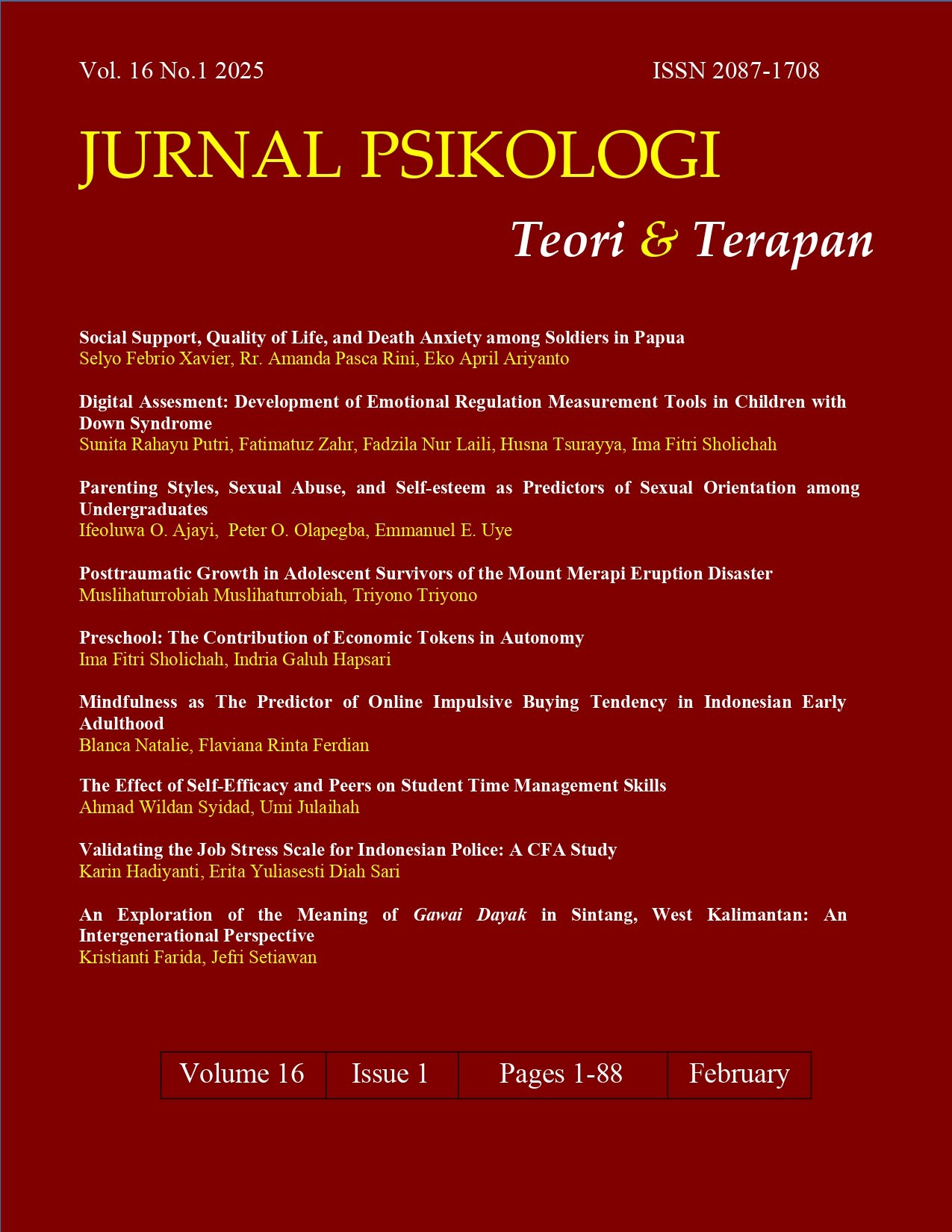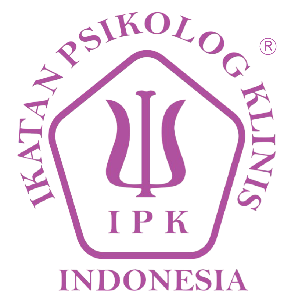Posttraumatic Growth in Adolescent Survivors of the Mount Merapi Eruption Disaster
DOI:
https://doi.org/10.26740/jptt.v16n01.p27-35Keywords:
Adolescents, mount Merapi eruption disaster, posttraumatic growthAbstract
Background: Natural disasters can cause material losses and psychological trauma, but on the other hand, it has the potential to trigger positive impacts such as post-traumatic growth (PTG). Therefore, this study will specifically examine PTG in adolescent survivors of the Mount Merapi eruption in Balerante Village, Kemalang, Central Java. Objective: Exploring more deeply about PTG (Post-Traumatic Growth) in adolescent survivors of the Merapi volcanic eruption in Balerante Village. Method: A qualitative phenomenological approach involving four subjects aged 19-24 years who directly experienced the Mount Merapi eruption disaster. Informants were selected using the snowball sampling technique. Data collection was conducted through observation and in-depth interviews. The data analysis technique employed was Interpretative Phenomenological Analysis (IPA). Result: The results showed that PTG in adolescent survivors of the Mount Merapi eruption was reflected in disaster preparedness, positive post-traumatic changes, and the emergence of new ambitions. Factors contributing to PTG included social support and individual spirituality. Conclusion: Trauma can be a turning point for adolescents, allowing them to grow into more resilient individuals in living their lives.
Keywords: Adolescents; mount Merapi eruption disaster; posttraumatic growth.
Abstrak
Latar Belakang: Bencana alam dapat menyebabkan kerugian materi, dan trauma psikologis, namun juga berpotensi memicu dampak positif seperti posttraumatic growth (PTG). Meski penelitian PTG pada penyintas bencana alam sudah banyak dilakukan, kajian spesifik tentang PTG pada remaja penyintas erupsi Gunung Merapi di Desa Balerante, Kemalang, Jawa Tengah, belum tersedia. Tujuan: Mengeksplorasi lebih mendalam mengenai PTG pada remaja penyintas bencana erupsi Gunung Merapi di Desa Balerante. Metode: Kualitatif fenomenologi yang melibatkan empat subjek berusia 19-24 tahun yang mengalami langsung bencana Erupsi Gunung Merapi. Informan dipilih melalui teknik snowball sampling. Pengambilan data menggunakan observasi dan wawancara mendalam. Teknik analisis data yang digunakan yaitu Interpretative Phenomenological Analysis (IPA). Hasil: Hasil penelitian ini menunjukkan PTG pada remaja penyintas bencana erupsi Merapi ditunjukkan dalam bentuk kesiagaan menghadapi bencana, perubahan positif setelah trauma, dan munculnya ambisi baru. Faktor pendorong yang mempengaruhi PTG diantaranya dukungan sosial dan spiritualitas pada masing-masing individu. Penelitian ini diharapkan dapat mendukung intervensi psikologis dan program penguatan potensi PTG. Simpulan: Trauma dapat menjadi titik balik bagi remaja untuk tumbuh menjadi individu yang lebih tangguh.dalam menjalani kehidupan.
Kata Kunci: Bencana erupsi gunung Merapi; posttraumatic growth; remaja.
References
Alqumairah, A. A. (2020). Dinamika Post-Traumatic Growth (PTG) Penyintas Bencana Alam Palu, Sulawesi Tengah. 1–54. http://repository.unhas.ac.id/id/eprint/1059/
Arifah, Z. M., & Indriyani, J. G. (n.d.). Menggali Kecemasan Tokoh Lian dalam Novel ’ Ingatan Ikan-Ikan ’: Pendekatan Psikologi Sastra Sigmund Freud. 55–77.
Asiva Noor Rachmayani. (2015). Eling lan Waspodo Sebagai Persepsi Masyarakat dalam Menghadapi Ancaman Erupsi Merapi di Wilayah Cangkringan, Sleman, Yogyakarta. 6.
Cao, C., Wang, L., Wu, J., Li, G., Fang, R., Cao, X., Liu, P., Luo, S., Hall, B. J., & Elhai, J. D. (2018). Patterns of Posttraumatic Stress Disorder Symptoms and Posttraumatic Growth in an Epidemiological Sample of Chinese Earthquake Survivors: A Latent Profile Analysis. Frontiers in Psychology, 9(AUG), 1–8. https://doi.org/10.3389/fpsyg.2018.01549
Ernawati, D., Mustikasari, & Panjaitan, R. U. (2020). Gambaran Post Traumatic Stress Disorder pada Korban Bencana Alam Post Erupsi Merapi Satu Dekade. Jurnal Ilmu Keperawatan Jiwa, 03(02), 101–112.
Fatiyah, T. (2016). Posttraumatic Growth Pada Korban Kecelakaan Lalu-Lintas. Seminar ASEAN 2nd Psycology and Humanity, 2008, 449–455.
Ferro, M. A., Leatherdale, S. T., Shanahan, L., Patte, K. A., & Dol, M. (2023). Self-concept in Adolescents with Physical-Mental Comorbidity. Journal of Multimorbidity and Comorbidity, 13. https://doi.org/10.1177/26335565231211475
Gosal, L. C., Ch Tarore, R., & Karongkong, H. H. (2018). Analisis Spasial Tingkat Kerentanan Bencana Gunung Api Lokon di Kota Tomohon. Jurnal Spasial, 5(2), 229–237.
Harwansyah, M., Sinaga, P., Hasana Putri, M., Munte, R. F., & Hasibuan, F. H. (2023). As-Syar’i: Jurnal Bimbingan & Konseling Keluarga Gambaran Trauma Yang Dialami Anak Korban Perceraian. As-Syar’i: Jurnal Bimbingan & Konseling Keluarga, 6(1), 193–204. https://doi.org/10.47476/assyari.v6i1.339
Henson, C., Canevello, A., & Truchot, D. (2022). PTSD and PTG in French and American Firefighters: A Comparative Study. International Journal of Environmental Research and Public Health, 19(19), 11973. https://doi.org/10.3390/ijerph191911973
Jousset, P., Pallister, J., & Surono. (2013). The 2010 Eruption of Merapi Volcano. Journal of Volcanology and Geothermal Research, 261, 1–6. https://doi.org/10.1016/j.jvolgeores.2013.05.008
Kurniati, E., Sari, N., & Nurhasanah, N. (2021). Pemulihan Pascabencana pada Anak Usia Dini dalam Perspektif Teori Ekologi. Jurnal Obsesi : Jurnal Pendidikan Anak Usia Dini, 6(2), 579–587. https://doi.org/10.31004/obsesi.v6i2.1026
Martin, A. (2021). Personal Characteristics That Relate to Posttraumatic Growth (PTG) in Australian Paramedics. https://doi.org/10.6084/m9.figshare.16577297.v1
Miragall, M., Herrero, R., Vara, M. D., Galiana, L., & Baños, R. M. (2021). The Impact of Strict and Forced Confinement due to the COVID-19 Pandemic on Positive Functioning Variables, Emotional Distress, and Posttraumatic Growth in a Spanish Sample. European Journal of Psychotraumatology, 12(1). https://doi.org/10.1080/20008198.2021.1918900
Monikha, S. M. (2017). Studi Analisa Sebaran Korban Jiwa Berdasarkan Usia dan Gender Pada Peta KRB Erupsi Gunungapi Merapi 2010. Jurnal Dialog Penanggulangan Bencana, 8 No. 1, 43–53.
Noordin, I. D., Anuar, N. A., Muhammad, N. A., Mohd Ghazali, Q., Idris, I. B., Hod, R., & Mohd Yusoff, H. (2020). Do Parenting Style and Adolescents’ Self-esteem Contribute to Mental Health Problems among Young Adolescents in Malaysia? An Adolescents’ Perspective. IIUM Medical Journal Malaysia, 19(2). https://doi.org/10.31436/imjm.v19i2.1568
Novanti, I. D., & Asiyah, S. N. (2023). Dinamika Post Traumatic Growth Pada Anak Berhadapan Dengan Hukum (ABH). Psycho Aksara : Jurnal Psikologi, 1(2), 170–178. https://doi.org/10.28926/pyschoaksara.v1i2.1023
Nurdiani, N. (2014). Teknik Sampling Snowball dalam Penelitian Lapangan. ComTech: Computer, Mathematics and Engineering Applications, 5(2), 1110. https://doi.org/10.21512/comtech.v5i2.2427
Salawali, S. H., Susanti, H., Daulima, N. H. C., & Putri, A. F. (2020). Posttraumatic Growth in Adolescent Survivors of Earthquake, Tsunami, and Liquefaction in Palu Indonesia: A Phenomenological Study. Pediatric Reports, 12(September 2018). https://doi.org/10.4081/pr.2020.8699
Smith, J. A., Larkin, M., & Flowers, P. (2021). Interpretative Phenomenological Analysis : Theory, Method and Research. SAGE Publications Ltd CN - BF.
Tazkiyah, A. Y. (2019). Resiliensi dan Post Traumatic Growth (PTG). Psikoborneo: Jurnal Ilmiah Psikologi, 7(3), 383–393. https://doi.org/10.30872/psikoborneo.v7i3.4796
Tedeschi, R. G., & Calhoun, L. (2004). Posttraumatic Growth : A New Perspective on Psychotraumatology. Psychiatric Times, 21(4), 8–14. https://www.bu.edu/wheelock/files/2018/05/Article-Tedeschi-and-Lawrence-Calhoun-Posttraumatic-Growth-2014.pdf
Tedeschi, R. G., & Calhoun, L. G. (1996). The Posttraumatic Growth Inventory: Measuring the Positive Legacy of Trauma. Journal of Traumatic Stress, 9(3), 455–471. https://doi.org/10.1002/jts.2490090305
Teixeira, R. J., & Pereira, M. G. (2013). Factors Contributing to Posttraumatic Growth and its Buffering Effect in Adult Children of Cancer Patients Undergoing Treatment. Journal of Psychosocial Oncology, 31(3), 235–265. https://doi.org/10.1080/07347332.2013.778932
Wahyu, W. A., Sutiaputri, L. F., & Heryana, W. (2020). Kerentanan Masyarakat Desa Balerante, Kemalang, Klaten, Terhadap Ancaman Bencana Letusan Gunung Merapi. Jurnal Ilmiah Pemberdayaan Dan Perlindungan Sosial, 2(2), 118–130.
Wardyaningrum, D. (2014). Perubahan Komunikasi Masyarakat Dalam Inovasi Mitigasi Bencana di Wilayah Rawan Bencana Gunung Merapi. Jurnal ASPIKOM, 2(3), 179. https://doi.org/10.24329/aspikom.v2i3.69
Warsini, S., West, C., Res Meth, G. C., Mills, J., & Usher, K. (2014). The Psychosocial Impact of Natural Disasters among Adult Survivors: An Integrative Review. Issues in Mental Health Nursing, 35(6), 420–436. https://doi.org/10.3109/01612840.2013.875085
Widodo, E. (2019). Potensi dan Ancamannya Bagi Sektor Pariwisata. 17(1), 21–34.
Yarni, S. S., & Komalasari, S. (2024). Dampak Trauma pada Gen Z dalam Aspek Kesejahteraan Psikis dan Psikologis Korban Perselingkuhan. Character Jurnal Penelitian Psikologi, 11(3), 1356–1365. https://doi.org/10.26740/cjpp.v11n3.p1356-1365.
Yulianto, S., Apriyadi, R. K., Aprilyanto, A., Winugroho, T., Ponangsera, I. S., & Wilopo, W. (2021). Histori Bencana dan Penanggulangannya di Indonesia Ditinjau Dari Perspektif Keamanan Nasional. PENDIPA Journal of Science Education, 5(2), 180–187. https://doi.org/10.33369/pendipa.5.2.180-187
Downloads
Published
How to Cite
Issue
Section
License
Copyright (c) 2025 Muslihaturrobiah Muslihaturrobiah, Triyono

This work is licensed under a Creative Commons Attribution 4.0 International License.
Authors who publish in this journal agree to the following terms:
Copyright in any article is held by the author.
The author grants the journal, publication rights with the work simultaneously licensed under a Creative Commons Attribution License that allows others to share the work with an acknowledgment of the work's authorship and initial publication in this journal.
Authors may enter into separate, additional contractual arrangements for the non-exclusive distribution of the journal's published version of the work (e.g., posting it to an institutional repository or publishing it in a book), with an acknowledgment of its initial publication in this journal.
Authors are permitted and encouraged to post their work online (e.g., in an institutional repository or on their website) prior to and during the submission process, as this can lead to productive exchanges, as well as earlier and greater citation of published work.
 Abstract views: 487
,
Abstract views: 487
, PDF Downloads: 412
PDF Downloads: 412


















